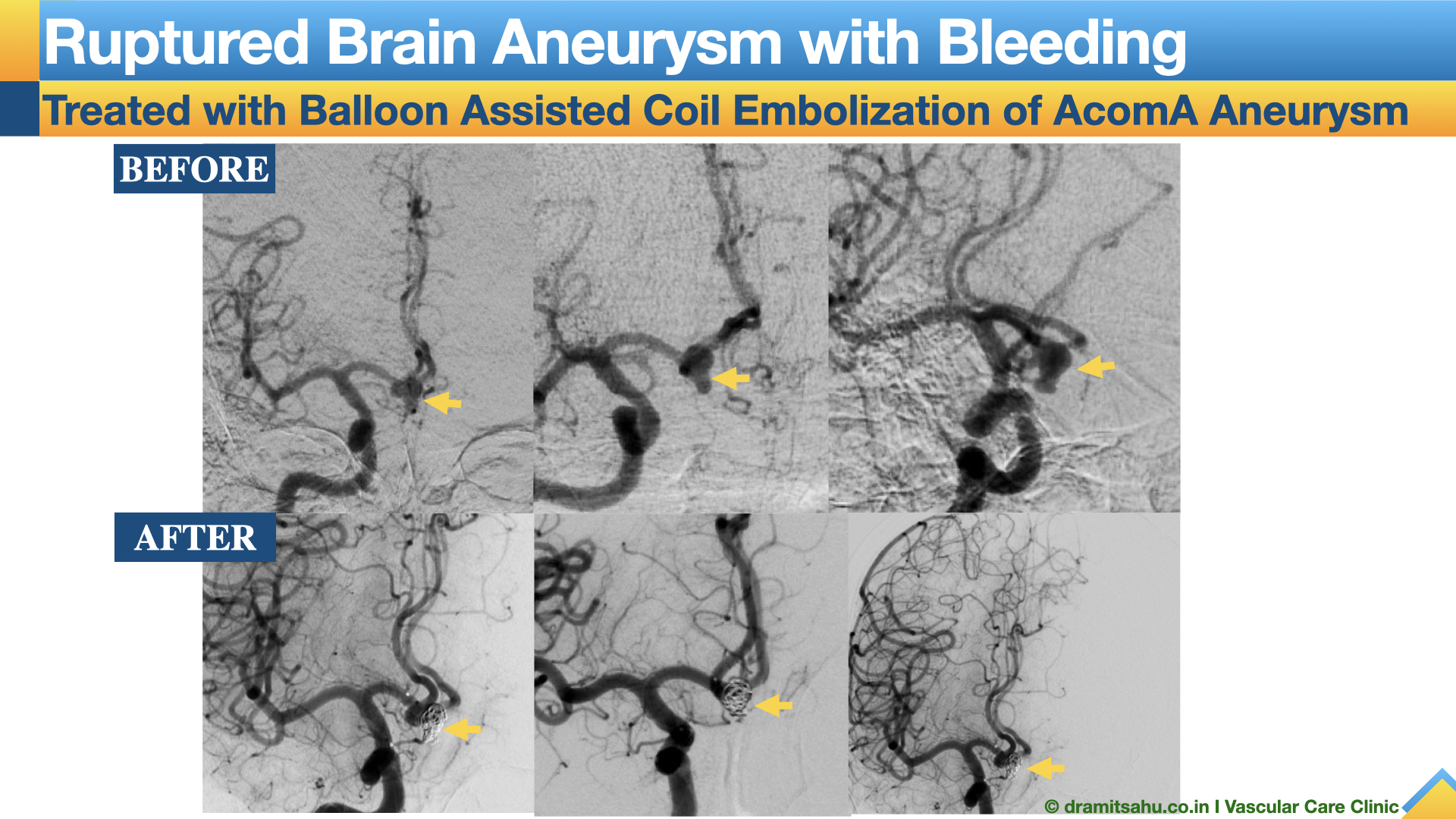Brain aneurysms are potentially life-threatening conditions that require immediate attention and advanced treatment options.
These weakened areas in the walls of brain arteries can rupture and cause bleeding in the brain, leading to severe neurological damage or even death.

The evolution of medical technology has paved the way for two primary treatment methods: coiling and clipping.
With the growing role of minimally invasive techniques, Interventional Radiology is now at the forefront of brain aneurysm care.
Dr. Amit Sahu, an eminent Interventional NeuroRadiology surgeon in Mumbai, specializes in Neuro-Radiology treatments, offering cutting-edge care for vascular and non-vascular conditions using image-guided interventions.
Understanding Brain Aneurysms
What is a Brain Aneurysm?
A brain aneurysm is a bulge or ballooning in a blood vessel in the brain, often resembling a berry hanging on a stem. Causes include high blood pressure, trauma, infections, and congenital abnormalities.
While many aneurysms remain asymptomatic, larger ones may cause:
- Sudden severe headache
- Blurred vision
- Neck stiffness
- Seizures
- Nausea or vomiting
Diagnosis of Brain Aneurysms
Accurate diagnosis is crucial for successful brain aneurysm treatment. These Techniques include:
- CT Angiography (CTA): Detects bleeding and the presence of an aneurysm.
- MR Angiography (MRA): Provides detailed images without radiation.
- Digital Subtraction Angiography (DSA): Gold standard for vascular imaging. It is the most sensitive method & may pick up aneurysms that might be missed on CT or MRI.
Treatment Options for Brain Aneurysms
Conservative Management
For small, unruptured aneurysms:
- Regular imaging surveillance
- Blood pressure control
- Lifestyle changes: quitting smoking, reducing stress
Surgical and Interventional Treatments
Two main procedures are performed based on the aneurysm’s characteristics:
- Coiling (Endovascular Embolization)
- Clipping (Microsurgical Clipping)
Coiling vs Clipping: What’s the Difference?
Coiling – A Minimally Invasive Approach
Performed by a highly trained Interventional NeuroRadiology surgeon in Mumbai like Dr. Amit Sahu. Coiling procedure involves:
- Inserting a catheter through a groin or wrist artery
- Navigating to the brain aneurysm site
- Deploying soft platinum coils into the aneurysm to induce clotting and block blood flow
Advantages:
- No open surgery
- Shorter recovery time
- Lower procedural risk
- Feasible even in areas where surgery is not possible or poses high risk – added it new
Best suited for:
- Patient with aneurysm who want non-surgical options
- Elderly or high-risk patients
- Deep-seated aneurysms
Clipping – A Traditional open Neurosurgical Technique
Microsurgical clipping involves:
- A craniotomy (opening the skull)
- Placing a metal clip across the aneurysm neck to stop blood flow
Advantages:
- Lower recurrence in some cases
Best suited for:
- Where evacuation of clot is also warranted
- Superficial aneurysms
Latest Innovations in Brain Aneurysm Treatment
Most of the latest advances for treating brain aneurysms have been in the field of Interventional NeuroRadiology.
Novel devices have made Interventional treatment of brain aneurysms faster, safer, better & durable. These include:
- Flow Diversion Devices
- Example: Pipeline Embolization Device (PED), Surpass, Fred
- These devices redirect blood flow away from the aneurysm sac
- Ideal for blister aneurysms, wide-neck, dissecting & giant aneurysms
- Intrasaccular Devices (e.g., WEB, Contour Device)
- Deployed inside the aneurysm
- Promotes clot formation from within
- Minimizes risk of vessel wall damage
- 3D Coil Technology
- Enhanced shape memory and flexibility
- Ensures dense aneurysm packing
- Reduces recurrence risk
How to Choose Between Coiling and Clipping?
Factors to Consider
- Interventional treatment for brain aneurysm offers option of avoiding an open surgery & faster recovery
- Size, shape, and location of the aneurysm
- Patient age and general health
- Previous history of rupture
- Physician expertise
Multidisciplinary Approach
Choosing between coiling and clipping involves collaboration among:
- Neurosurgeons
- Neurologists
- Interventional NeuroRadiology surgeons like Dr. Sahu in Mumbai
Personalized treatment ensures optimal outcomes for each patient.
Why Choose Dr. Amit Sahu for Brain Aneurysm Treatment in Mumbai?
Dr. Amit Sahu is amongst leading brain aneurysm surgeon in Mumbai known for his expertise in Interventional Radiology and Neuro-Radiology. His approach includes:
- Minimally invasive procedures
- Latest imaging and navigation technologies
- Compassionate and individualized care
- Excellent track record in managing complex aneurysms
Patients seeking brain aneurysm treatment in Mumbai can rely on Dr. Sahu’s advanced techniques and holistic care model.
FAQs: Coiling vs Clipping in Brain Aneurysm Treatment
Q1. Is coiling safer than clipping for brain aneurysms?
A: Coiling is less invasive and often safer for elderly, high-risk patients. The choice depends on the aneurysm type and patient condition.
Q2. Can aneurysms recur after coiling or clipping?
A: Yes, though rare. Regular follow-ups with imaging tests help monitor recurrence.
Q3. How long is the recovery period for coiling vs clipping?
A: Coiling usually requires 2–3 days of hospital stay, while clipping may need a week or more. Overall recovery is also dictated by the complications arising out the bleeding in case the aneurysm has ruptured.
Q4. What are the risks associated with these procedures?
A: Possible risks include bleeding, infection, or stroke. Choosing an experienced brain aneurysm surgeon in Mumbai helps mitigate these risks.
Q5. How can I consult Dr. Amit Sahu for Brain Aneurysm Treatment in Mumbai?
A: You can consult Dr. Amit Sahu at his clinic or hospital in Mumbai. He offers expert diagnosis and treatment for various types of brain aneurysms using minimally invasive techniques.
Conclusion
Understanding the difference between coiling and clipping is essential when facing a brain aneurysm diagnosis. Both procedures have their merits, and with recent technological innovations, outcomes are better than ever.
For the most effective and personalized brain aneurysm treatment in Mumbai, trust the expertise of Dr. Amit Sahu – a distinguished Interventional NeuroRadiology surgeon in Mumbai with a proven track record in neurovascular care.